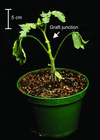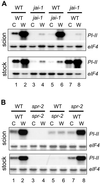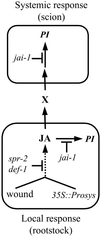Distinct roles for jasmonate synthesis and action in the systemic wound response of tomato
- PMID: 11959903
- PMCID: PMC122963
- DOI: 10.1073/pnas.072072599
Distinct roles for jasmonate synthesis and action in the systemic wound response of tomato
Abstract
Plant defense responses to wounding and herbivore attack are regulated by signal transduction pathways that operate both at the site of wounding and in undamaged distal leaves. Genetic analysis in tomato indicates that systemin and its precursor protein, prosystemin, are upstream components of a wound-induced, intercellular signaling pathway that involves both the biosynthesis and action of jasmonic acid (JA). To examine the role of JA in systemic signaling, reciprocal grafting experiments were used to analyze wound-induced expression of the proteinase inhibitor II gene in a JA biosynthetic mutant (spr-2) and a JA response mutant (jai-1). The results showed that spr-2 plants are defective in the production, but not recognition, of a graft-transmissible wound signal. Conversely, jai-1 plants are compromised in the recognition of this signal but not its production. It was also determined that a graft-transmissible signal produced in response to ectopic expression of prosystemin in rootstocks was recognized by spr-2 but not by jai-1 scions. Taken together, the results show that activation of the jasmonate biosynthetic pathway in response to wounding or (pro)systemin is required for the production of a long-distance signal whose recognition in distal leaves depends on jasmonate signaling. These findings suggest that JA, or a related compound derived from the octadecanoid pathway, may act as a transmissible wound signal.
Figures





Comment in
-
Systemic wound signaling in plants: a new perception.Proc Natl Acad Sci U S A. 2002 May 14;99(10):6519-20. doi: 10.1073/pnas.112196499. Proc Natl Acad Sci U S A. 2002. PMID: 12011413 Free PMC article. No abstract available.
References
Publication types
MeSH terms
Substances
Grants and funding
LinkOut - more resources
Full Text Sources
Other Literature Sources

